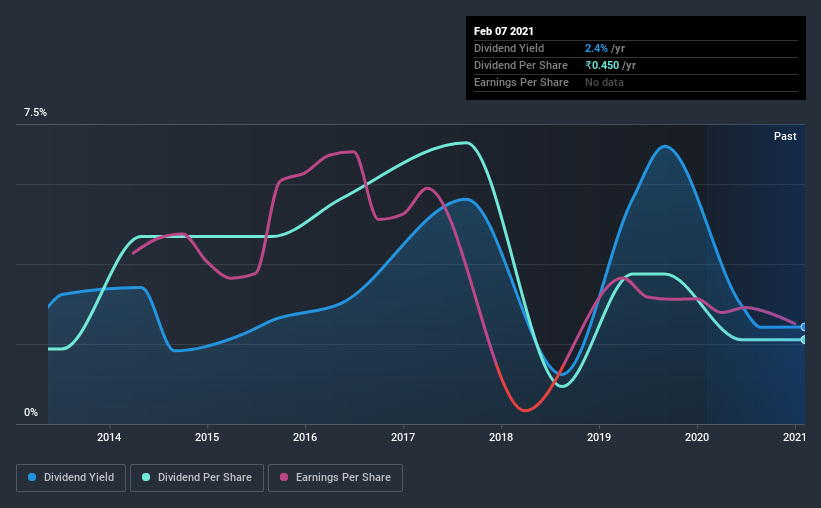- India
- /
- Diversified Financial
- /
- NSEI:PFS
Key Things To Consider Before Buying PTC India Financial Services Limited (NSE:PFS) For Its Dividend

Is PTC India Financial Services Limited (NSE:PFS) a good dividend stock? How can we tell? Dividend paying companies with growing earnings can be highly rewarding in the long term. Yet sometimes, investors buy a stock for its dividend and lose money because the share price falls by more than they earned in dividend payments.
Investors might not know much about India Financial Services's dividend prospects, even though it has been paying dividends for the last eight years and offers a 2.4% yield. While the yield may not look too great, the relatively long payment history is interesting. Some simple analysis can offer a lot of insights when buying a company for its dividend, and we'll go through this below.
Explore this interactive chart for our latest analysis on India Financial Services!

Payout ratios
Companies (usually) pay dividends out of their earnings. If a company is paying more than it earns, the dividend might have to be cut. Comparing dividend payments to a company's net profit after tax is a simple way of reality-checking whether a dividend is sustainable. Looking at the data, we can see that 34% of India Financial Services' profits were paid out as dividends in the last 12 months. This is a middling range that strikes a nice balance between paying dividends to shareholders, and retaining enough earnings to invest in future growth. One of the risks is that management reinvests the retained capital poorly instead of paying a higher dividend.
Consider getting our latest analysis on India Financial Services' financial position here.
Dividend Volatility
From the perspective of an income investor who wants to earn dividends for many years, there is not much point buying a stock if its dividend is regularly cut or is not reliable. Looking at the last decade of data, we can see that India Financial Services paid its first dividend at least eight years ago. It's good to see that India Financial Services has been paying a dividend for a number of years. However, the dividend has been cut at least once in the past, and we're concerned that what has been cut once, could be cut again. During the past eight-year period, the first annual payment was ₹0.4 in 2013, compared to ₹0.5 last year. This works out to be a compound annual growth rate (CAGR) of approximately 1.5% a year over that time. India Financial Services' dividend payments have fluctuated, so it hasn't grown 1.5% every year, but the CAGR is a useful rule of thumb for approximating the historical growth.
It's good to see some dividend growth, but the dividend has been cut at least once, and the size of the cut would eliminate most of the growth, anyway. We're not that enthused by this.
Dividend Growth Potential
With a relatively unstable dividend, it's even more important to see if earnings per share (EPS) are growing. Why take the risk of a dividend getting cut, unless there's a good chance of bigger dividends in future? India Financial Services' earnings per share have shrunk at 27% a year over the past five years. With this kind of significant decline, we always wonder what has changed in the business. Dividends are about stability, and India Financial Services' earnings per share, which support the dividend, have been anything but stable.
Conclusion
Dividend investors should always want to know if a) a company's dividends are affordable, b) if there is a track record of consistent payments, and c) if the dividend is capable of growing. We're glad to see India Financial Services has a low payout ratio, as this suggests earnings are being reinvested in the business. Earnings per share are down, and India Financial Services' dividend has been cut at least once in the past, which is disappointing. India Financial Services might not be a bad business, but it doesn't show all of the characteristics we look for in a dividend stock.
Companies possessing a stable dividend policy will likely enjoy greater investor interest than those suffering from a more inconsistent approach. Meanwhile, despite the importance of dividend payments, they are not the only factors our readers should know when assessing a company. Case in point: We've spotted 4 warning signs for India Financial Services (of which 1 is a bit concerning!) you should know about.
We have also put together a list of global stocks with a market capitalisation above $1bn and yielding more 3%.
If you’re looking to trade India Financial Services, open an account with the lowest-cost* platform trusted by professionals, Interactive Brokers. Their clients from over 200 countries and territories trade stocks, options, futures, forex, bonds and funds worldwide from a single integrated account. Promoted
New: Manage All Your Stock Portfolios in One Place
We've created the ultimate portfolio companion for stock investors, and it's free.
• Connect an unlimited number of Portfolios and see your total in one currency
• Be alerted to new Warning Signs or Risks via email or mobile
• Track the Fair Value of your stocks
This article by Simply Wall St is general in nature. It does not constitute a recommendation to buy or sell any stock, and does not take account of your objectives, or your financial situation. We aim to bring you long-term focused analysis driven by fundamental data. Note that our analysis may not factor in the latest price-sensitive company announcements or qualitative material. Simply Wall St has no position in any stocks mentioned.
*Interactive Brokers Rated Lowest Cost Broker by StockBrokers.com Annual Online Review 2020
Have feedback on this article? Concerned about the content? Get in touch with us directly. Alternatively, email editorial-team (at) simplywallst.com.
About NSEI:PFS
PTC India Financial Services
A non-banking finance company, provides various financing solutions primarily in India.
Adequate balance sheet and slightly overvalued.
Market Insights
Community Narratives



